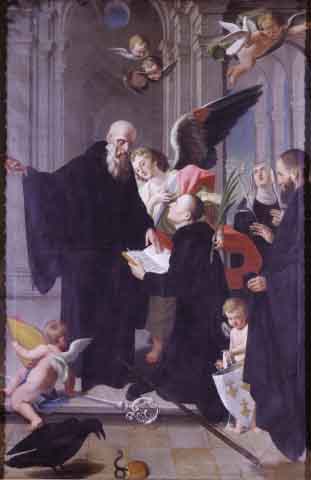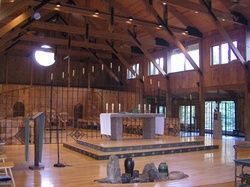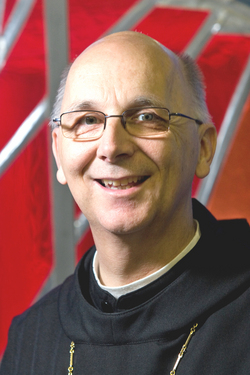This morning in my inbox I found a fine human interest story on a relationship being built between a colony of Benedictine monks and academics and students of business from a Jesuit university. The key to this whole story is mutual understanding and respect for the other and lived culture, that is genuine friendship. In this case, the monks of Conception Abbey and Rockhurst University School of Management’s professors and students. Read the story… Pray for each group.
Tag: Benedictine
Father Charles Dumont, Cistercian monk, priest, poet: RIP
On the solemnity of the Nativity of the Lord, a few
hours after the Midnight Mass (in which he participated from his room), Father
Charles Dumont was born into eternal life. Born in Ixelles (Brussels) on 26
September 1918, he entered Scourmont Abbey on 11 June 1941, he professed solemn
vows on 16 July 1946, and was ordained priest on 15 May 1950. He served
several times as chaplain at the abbey of Notre Dame de la Paix (Chimay), as
well as at Soleilmont. For several years he assisted at Caldey and he filled the
office of Novice Master at Scourmont from 1993 to 1996.
people, especially within the Order, to the knowledge and the love of the
Cistercian Fathers, in particular St Bernard. He was the editor of Collectanea
Cistercienia, later Cisterciensia (1963-71) and assisted in the editing of Cistercian Studies Quarterly. Two of his
recent works are Pathways to Peace: Cistercian Wisdom According to St. Bernard
and Praying the Word of God. Cistercian Sister Elizabeth Connor wrote a book on
Father Charles entitled, Charles Dumont Monk-Poet: A Spiritual Biography. His
funeral took place at Scourmont on 28 December. May God grant Father Charles eternal light, peace and happiness.
Benedictine named bishop in Chur, Switzerland: Abbot Dr. Marian Eleganti
Abbot Dr. Marian Eleganti, 54, until now the Abbot of the Abbey of Saint Otmasberg (Abtei St. Otmarsberg), has been nominated by the Holy Father to be an auxiliary bishop of the Diocese of Chur, Switzerland. He was elected abbot of his monastery on 15 July 1999 and in 2003 defended a doctoral dissertation on Romano Guardini at the University of Salzburg. Abbot Marian speaks seven languages and is a published author.
The Abbey of Saint Otmasberg belongs to the Congregation of Saint Ottilien, a grouping of missionary Benedictine monks who take vows to a particular monastery as other monks do, but since mission work is their common apostolate, monks are assigned from various monasteries for this mission work in monasteries in other parts of the world. This congregation of monks have a slightly different understanding of the monastic of stability but no less vital for monasticism and for the Church. There are two monasteries of the Congregation of Saint Ottilien in the USA: Saint Paul’s Abbey (Newton, NJ) and Christ the King Priory (Schuyler, NE).
Bishop-elect Marian is one of 32 Benedictine monks ordained to the episcopacy worldwide.
May God grant many years to Bishop-elect Marian and may Saint Ambrose sustain the bishop with his prayers. So, we pray for Abbot Marian and for his Benedictine community who will now prepare to elect a new abbot.
Rule of Saint Benedict
 The monks of Saint Benedict’s Abbey have put on their
The monks of Saint Benedict’s Abbey have put on their
website Father Boniface Verheyen’s translation of the Rule of Saint Benedict. The monks at this Abbey have a terrific college and get a steady stream of vocations. This year they have 7 novices: three for Kansas and four for Brazil.
The Christian announcement is that God became one of us and is present here,
and gathers us together into one body, and through this unity, His presence is
made perceivable. This is the heart of the Benedictine message of the
earliest times. Well, this also defines the entire message of our Movement,
and this is why we feel Benedictine history to be the history to which we
are closest.
Liberation
reserving much time for it in the daily schedule, will not fail to instill
serene trust, to cast aside false security and to root in the soul a vivid
sense of the total lordship of God. The monk is thus protected from convenient
or utilitarian interpretations of Scripture and brought to an ever deeper
awareness of human weakness, in which God’s power shines brightly.
Paul II
Father John Oetgen, OSB, RIP
The Oblates of Belmont Abbey posted this obit for Father John.
The response to God’s word is telling
First comes the word of God that addresses me, touches
me, calls me into question, wounds and judges me, but also heals and frees me.
Both prayer and silence can only be an answer to God’s word and may not precede
it.
monastic is to respond to the word of God and express his or her readiness to
follow God’s demands with deeds. Thus we find in Benedict’s Rule no teaching on
mystical prayer, but very sober instruction to open one’s daily life to God
again and again in every situation.
living before God, in God’s presence, listening to God’s word that addresses us
and shows us the way. In prayer the monastic responds that she or he has heard
God’s word and is now ready to follow it.
Today
Seeing the Invisible will allow you to do the impossible
The monks of Cistercian Abbey, Spring Bank, WI, are featured in a PBS video.
The hard work of being a person of peace
The Benedictine ideal of the human being is not that
of one who achieves and accomplishes things, not a person with an unusual
religious gift, not a great ascetic, but the wise and mature person who knows
how to bring people together, who creates around herself or himself an
atmosphere of peace and mutual understanding.
high demand. No one can simply resolve to become a peacemaker. Only those who
have created peace within themselves can make peace, only those who have become
reconciled with themselves, their own weaknesses and faults, their needs and
desires, their contradictory tendencies and ambitions.
program of action that one could write on one’s banners; rather, it must arise
from inner peace. And inner peace is achieved only through a hard and
unremitting struggle for inner purity and through prayer, in which one seeks to
accept everything God presents, whether one’s own weaknesses or those of
others.
Visiting Bethlehem: the Abbey of Regina Laudis
 One of the blessings in Connecticut is the presence of Abbey of Regina Laudis, a monastery of nearly 40 Benedictine nuns in the hills of Litchfield, County (in the Archdiocese of Hartford). Looking out in the choir there were 5 white veil novices and 1 postulant among the other professed nuns.
One of the blessings in Connecticut is the presence of Abbey of Regina Laudis, a monastery of nearly 40 Benedictine nuns in the hills of Litchfield, County (in the Archdiocese of Hartford). Looking out in the choir there were 5 white veil novices and 1 postulant among the other professed nuns.
 Additionally, the abbey has through the years attracted women from all walks of life and pedigree: some have been lawyers, physicians, artists, poets, actresses, theologians, minor nobility and the like. Mother Foundress’ leadership and vision was the result of the integration of faith and reason. She knew deeply the Catholic tradition of the religious, artistic and intellectual life. Hers was a monastic life that is virtually unknown in the United States. Regina Laudis is likely one of 4 or 5 similar monasteries of women. Historically, Mother Benedict knew personally Popes Pius XII, John XXIII and Paul VI and all of them encouraged the Foundress to keep alive Benedictine culture, ecumenism, the Latin chants and the intellect (that is, if a woman came to the abbey is a professional credential, or later earned one, she was keep current in that field).
Additionally, the abbey has through the years attracted women from all walks of life and pedigree: some have been lawyers, physicians, artists, poets, actresses, theologians, minor nobility and the like. Mother Foundress’ leadership and vision was the result of the integration of faith and reason. She knew deeply the Catholic tradition of the religious, artistic and intellectual life. Hers was a monastic life that is virtually unknown in the United States. Regina Laudis is likely one of 4 or 5 similar monasteries of women. Historically, Mother Benedict knew personally Popes Pius XII, John XXIII and Paul VI and all of them encouraged the Foundress to keep alive Benedictine culture, ecumenism, the Latin chants and the intellect (that is, if a woman came to the abbey is a professional credential, or later earned one, she was keep current in that field).Benedictine missionary reflects
A Benedictine monk and priest for more than 50 years reflects on his vocation as a missionary in Africa. His call from the Lord may be spoken of as a call within a call found in a call. After all, he said he abandoned his will into the hands of the Divine Will. Father Damian Milliken is a monk of a missionary group of Benedictine monks who work around the world in local monasteries while doing proper missionary work of friendship, evangelization and projects of social concern. Read Father Milliken’s story.

